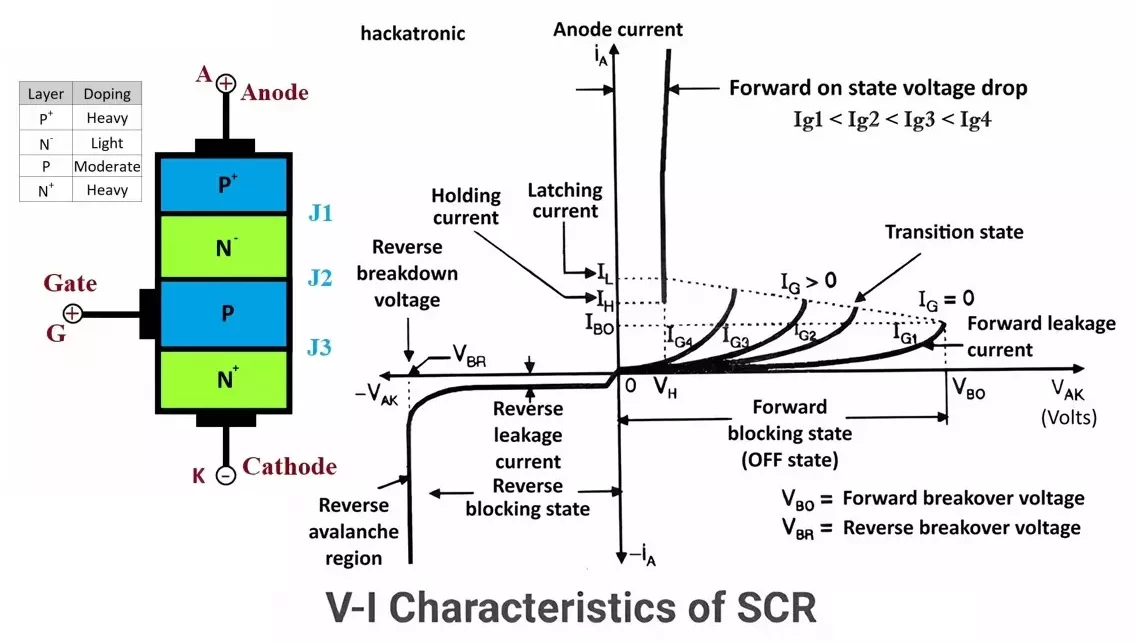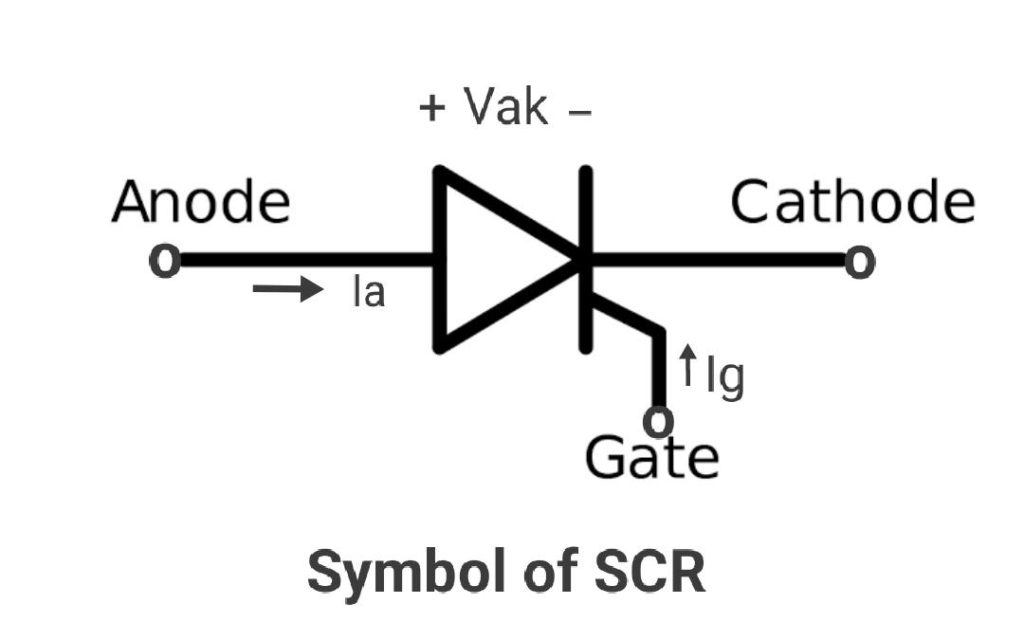The VI characteristics of SCR (silicon-controlled rectifier) is a graph of anode current Ia on the y-axis and anode to cathode voltage on the x-axis as shown in the graph.
It describes the relationship between the voltage across the device and the current flowing through it. The characteristics in the reverse direction (anode to cathode voltage negative) is similar to a reverse-biased diode. SCR is a member of the thyristor family.
I will suggest you read the Working of silicon controlled rectifier SCR. also Applications of SCR.
Understanding VI characteristics is crucial for designing and implementing SCRs in various applications. The VI characteristics can be divided into three primary modes of operation:
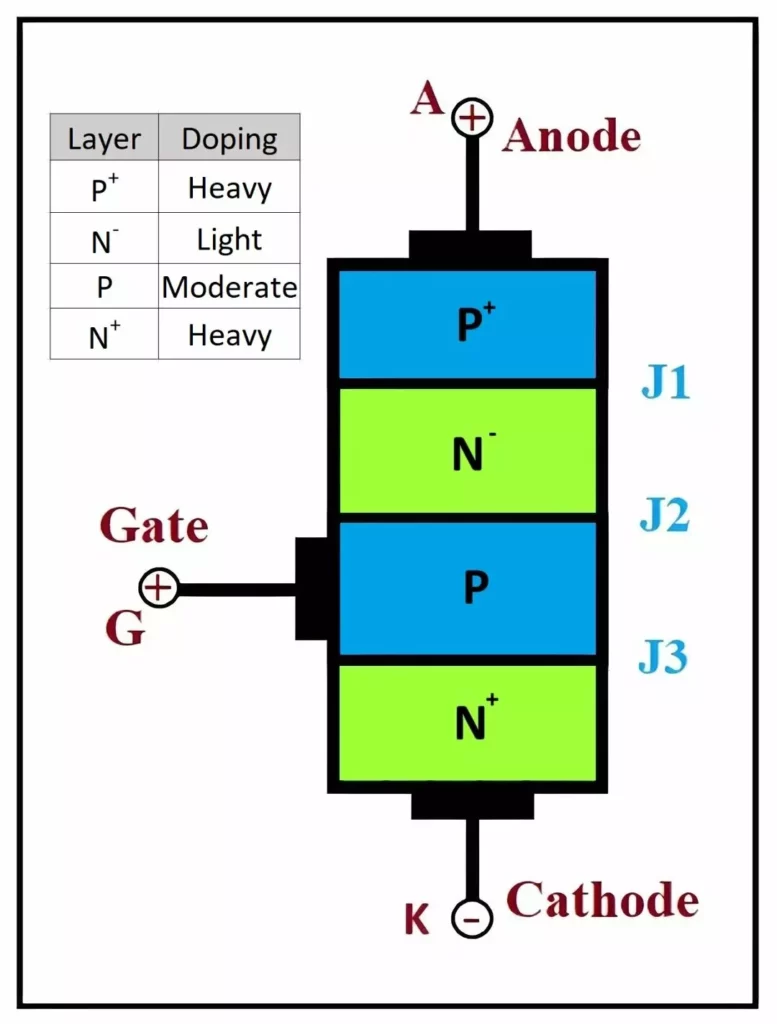
Forward Blocking Mode (OFF State):
- Anode to Cathode Voltage (V_AK): Positive
- Gate Current (I_G): Zero
In this mode, a positive voltage is applied to the anode with respect to the cathode, but no gate current is applied. The junctions J1 and J3 are forward biased, while J2 is reverse biased, creating a depletion region at J2 which prevents significant current flow.
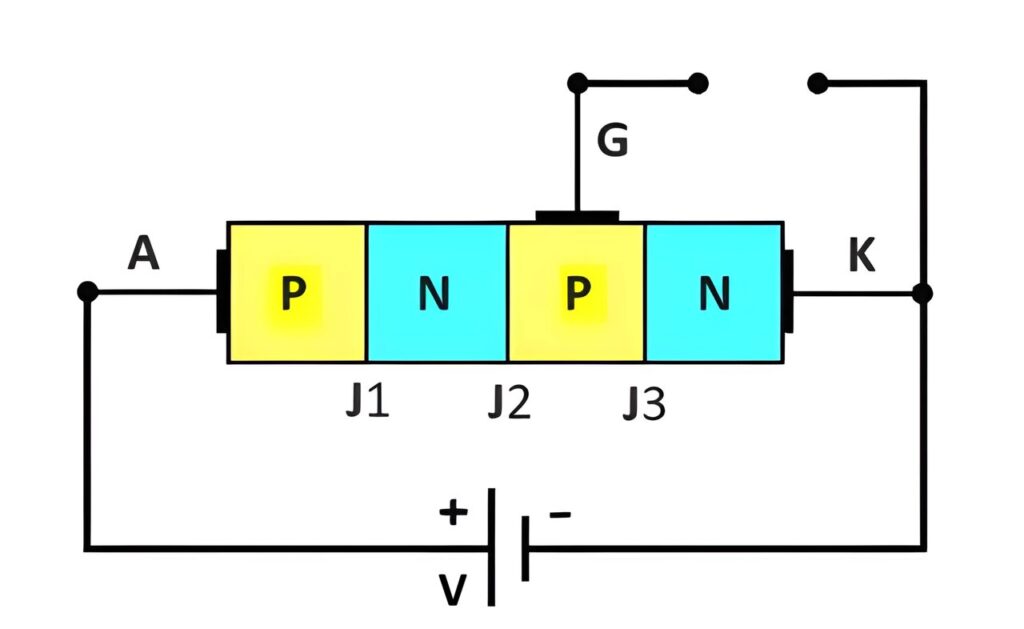
- Current (I_A): Very small leakage current flows due to minority carriers.
- Voltage (V_AK): The voltage across the SCR increases without significant current flow until it reaches the forward breakover voltage (V_BO).
Forward Conduction Mode (ON State):
- Anode to Cathode Voltage (V_AK): Positive
- Gate Current (I_G): Applied (positive pulse)
When a positive gate current is applied, or the anode-to-cathode voltage exceeds the breakover voltage, the depletion region at junction J2 collapses, allowing current to flow freely.
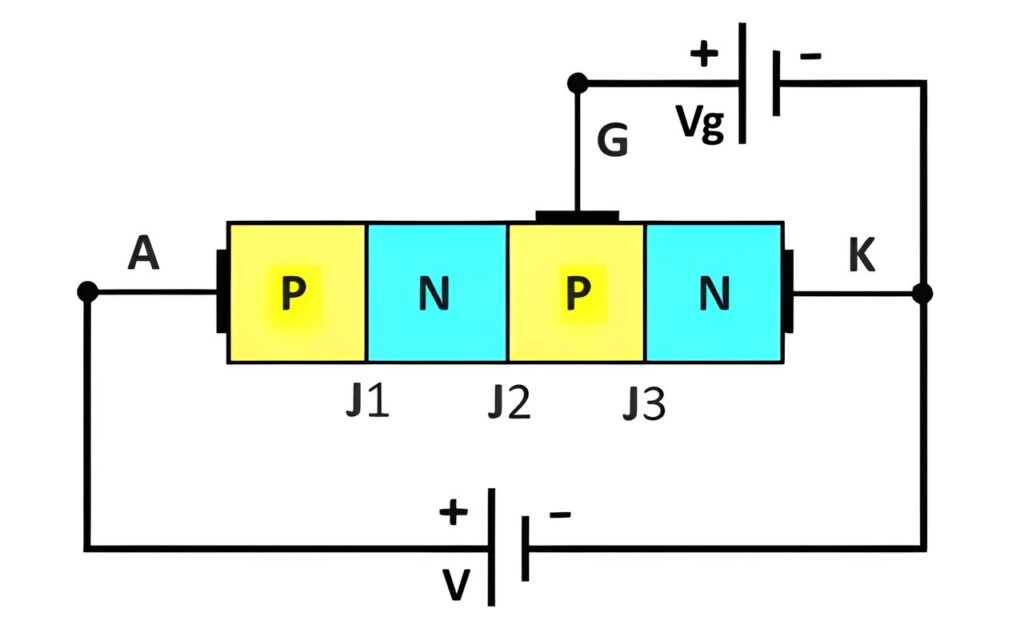
- Current (I_A): Increases rapidly after turn-on, determined by the external circuit.
- Voltage (V_AK): Drops to a low value, typically in the range of 1-2 volts, due to the low on-state resistance of the SCR.
Once the SCR is in conduction mode, the gate current can be removed, and the SCR will remain on as long as the anode current remains above the holding current (I_H).
Reverse Blocking Mode (OFF State):
- Anode to Cathode Voltage (V_AK): Negative
In this mode, a negative voltage is applied to the anode with respect to the cathode. Junctions J1 and J3 are reverse biased, while J2 is forward biased.
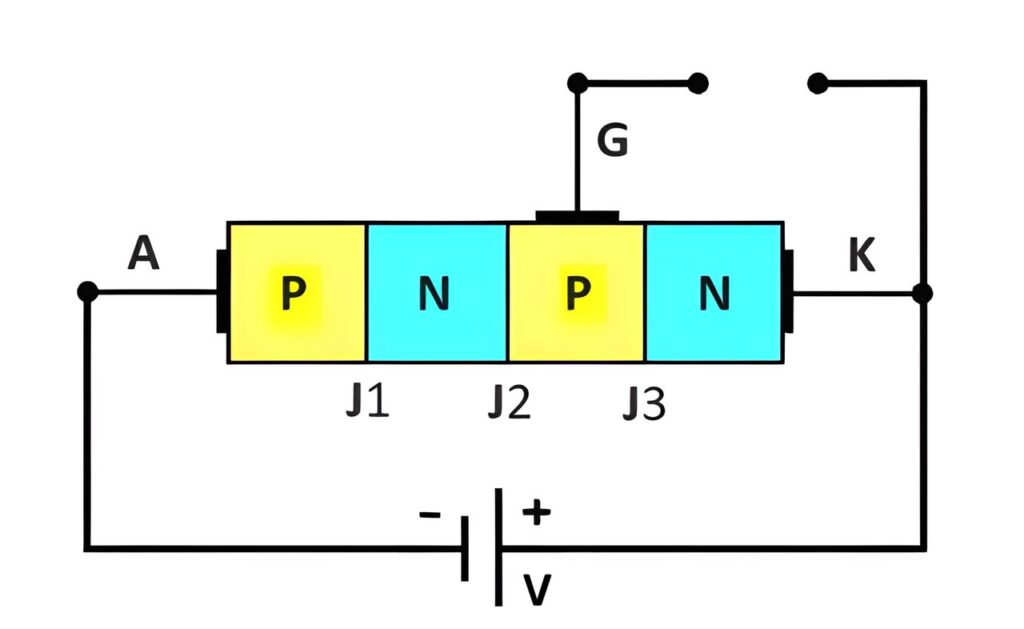
- Current (I_A): Only a small leakage current flows.
- Voltage (V_AK): The voltage increases up to the reverse breakdown voltage (V_BR). Beyond this point, avalanche breakdown occurs, which can result in high reverse current and potential damage to the SCR.
VI characteristic of SCR:
The VI characteristics of SCR can be split into two parts namely
- Forward characteristics
- Reverse characteristics
For small reverse voltage, a small reverse leakage current flows. until the avalanche breakdown takes place at reverse breakover voltage Vbr.
As soon as the reverse breakdown takes place due to avalanche breakdown, a large current flows through SCR whereas the voltage across the device remains constant.
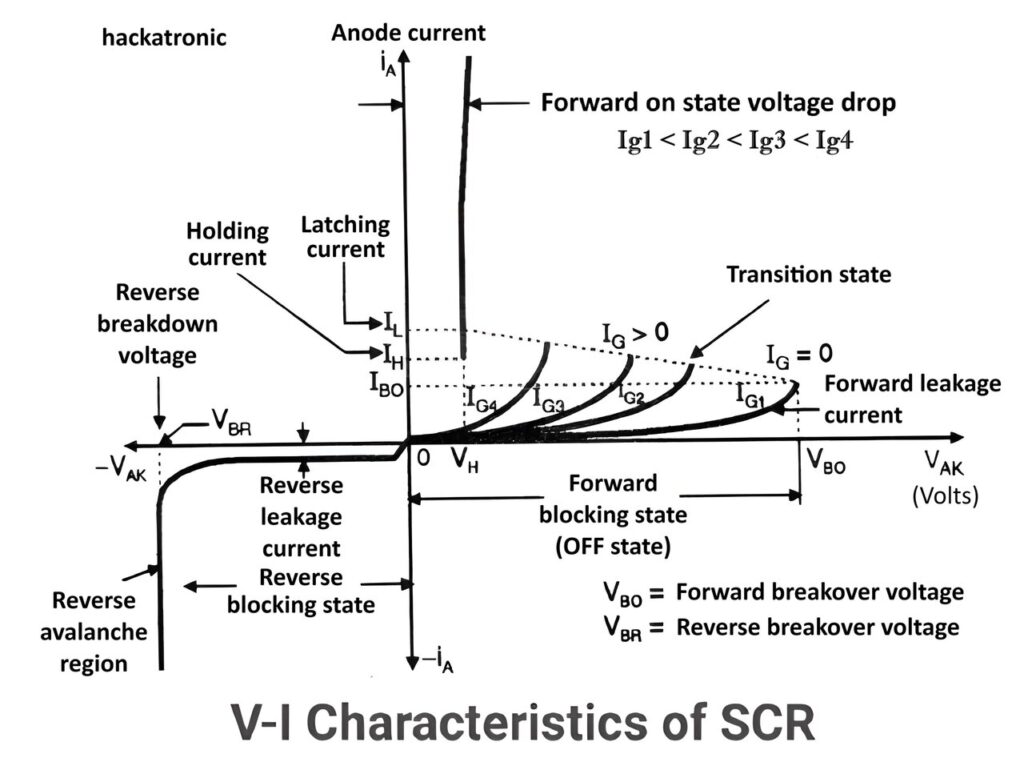
It is dangerous to operate SCR in the reverse breakdown state because it may get damaged due to overheating.
The region from 0 Volts up to Vbr volts in which the SCR is reverse biased and non-conducting is called as “reverse blocking state”. Reverse blocking means that the SCR is reverse biased and in the non-conducting (blocking) state.
Forward characteristics of SCR:
The anode is positive with respect to the cathode. Hence SCR is forward biased.
The forward characteristics are divided into three regions of operation namely:
- Forward blocking state.
- Transition state.
- ON state.
Forward blocking state:
This is the high voltage low current mode of operation in which SCR is in the OFF state. The current through it is “Forward Leakage Current” This current flows due to thermally generated minority carriers.
Transition state:
SCR remains in the blocking state as long as the forward anode to cathode voltage is less than the breakover voltage.
As soon as Vak becomes greater than the breakover value, and the anode current Ia increases sharply to a high value and the voltage across SCR reduces sharply to a low value (on-state voltage).
The switching of SCR from off state to on state and vice versa takes place in a short time. This changeover state is called as transition state. As this is an unstable state, it is shown by the dotted line.
ON state:
The voltage across SCR is low in this state. In the on-state the SCR anode currents is large, and the on-state voltage drop is small.
Unstable state:
These two stable states or modes are connected by an unstable mode (called as transition state) of operation that appears as a negative resistance on the I-V characteristics.
The important terms in the IV characteristics are as follows:
Here are the most important terms in the VI Characteristics of SCR.
The forward breakover voltage (Vbo):
This is the maximum forward voltage that can be applied between anode and cathode, without initiating forward conduction. This voltage is defined for a zero-gate current. In short, this is the maximum forward voltage across SCR in its off state.
The forward leakage current:
The small forward current flowing in the forward blocking state of the device. This current is generated due to the minority current carriers and therefore is dependent on the operating temperature.
The holding current (Ih):
It represents the minimum current that can flow through SCR and still “hold” it in the on state. The voltage associated with the holding current is termed as holding voltage Vh.
If the forward anode current is reduced below holding current, SCR will be turned off. The holding current is defined for zero gate current (Ig = 0), it is denoted by Ih and its value is few mA.
ON-state voltage:
Note that the voltage across SCR in its on state is very low as compared to the off-state voltage. It can be shown that the on-state voltage is equal to drop across one junction (1 to 1.5 Volts).
Latching current (il):
It is the minimum anode current that must flow through SCR to latch it into the on-state. The latching current is higher than the holding current. The latching current is important when SCR is being turned on.
Difference between holding current and latching currents:
- The latching current is important only at the time of SCR turn on, whereas holding current is important only at the time of SCR turn off.
- If the anode current goes below the holding current then the conducting SCR turns off. The holding current is defined for If = 0, whereas if anode current at the time of turn-on is higher than the latching current then only SCR will latch into its on state.
- If Ia < IL then SCR does not latch. It will remain on as long as Ig is being supplied. As soon as Ig is removed, SCR will turn off.
- The latching current is always higher than the holding current.
- The values of IL and Ih are constant. They do not depend on the gate current magnitude.
Effect of gate current:
The graph shows that as we increase the positive gate current from Ig1 to Ig4, the breakover voltage of SCR Vbo reduces progressively. Thus SCR will turn on at lower anode to cathode voltages as we increase the gate current.
Reverse Characteristics of SCR:
The reverse characteristic of an SCR is very similar to that of a diode.
As long as the reverse anode to cathode voltage is less than the reverse breakover voltage, a small reverse current flows due to minority carriers.
But as soon as a reverse voltage equal to or greater than breakdown voltage is applied, a very large anode current flows due to avalanche breakdown. This should be avoided to protect the SCR from getting damaged.
Summary:
The VI characteristics of SCR can be summarized as follows:
Forward Blocking Region:
V_AK < V_BO: The SCR is in the off state with a very small leakage current.
Breakover Voltage (V_BO): The voltage at which the SCR switches to the on state without gate current.
Forward Conduction Region:
V_AK > V_BO (or with gate current I_G): The SCR is in the on state with a significant anode current (I_A).
On-State Voltage (V_ON): The voltage drop across the SCR when it is conducting, typically 1-2V.
Holding Current (I_H): The minimum anode current required to keep the SCR in the on state.
Reverse Blocking Region:
Negative V_AK: The SCR is in the off state with a small leakage current.
Reverse Breakdown Voltage (V_BR): The voltage at which the SCR experiences avalanche breakdown, leading to high reverse current.
SCR as a Switch, its Advantages, Disadvantages and Applications
